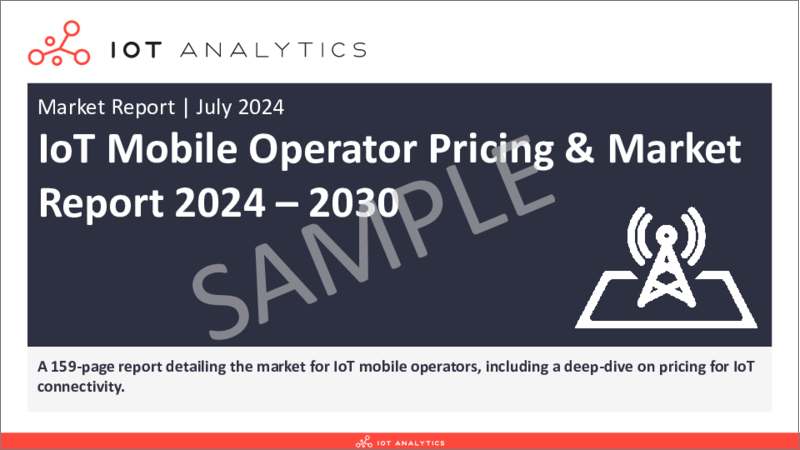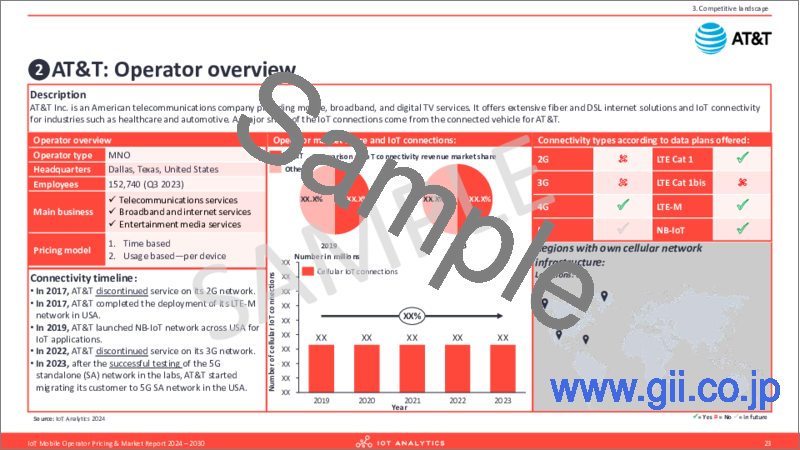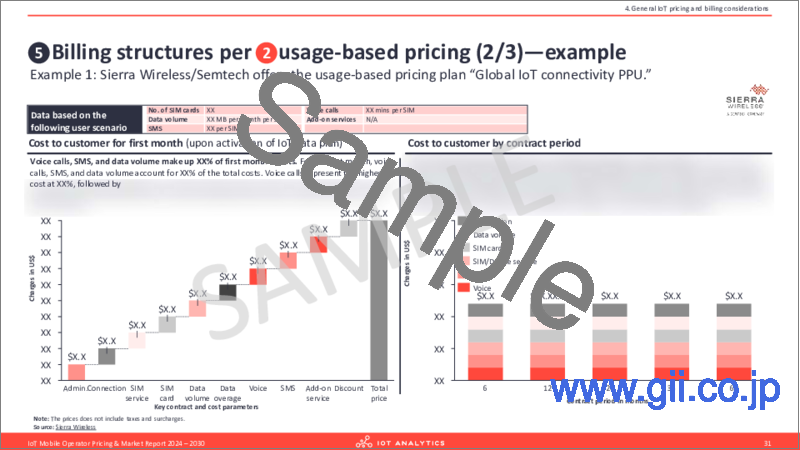|
|
市場調査レポート
商品コード
1507976
IoTモバイル事業者の料金および市場 (2024~2030年)IoT Mobile Operator Pricing and Market Report 2024-2030 |
||||||
|
|||||||
| IoTモバイル事業者の料金および市場 (2024~2030年) |
|
出版日: 2024年07月05日
発行: IoT Analytics GmbH
ページ情報: 英文 159 Pages
納期: 即日から翌営業日
|
全表示
- 概要
- 目次
当レポートは、IoT AnalyticsによるIoTハードウェアとコネクティビティに関する継続的調査の一環であり、モバイル通信事業者 (MNO) および仮想移動体通信事業者 (MVNO) によるさまざまなタイプの接続、データプラン、主な提供サービスに関する具体的な洞察を提供しています。また、IoTモバイル事業者による料金のベンチマークを掲載し、地域や接続タイプ別のIoT料金ダイナミクスに関する貴重な洞察を提供しています。
サンプルビュー
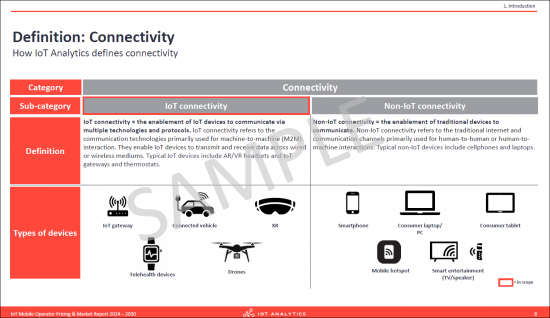
サンプルビュー
定義:ネットワーク事業者
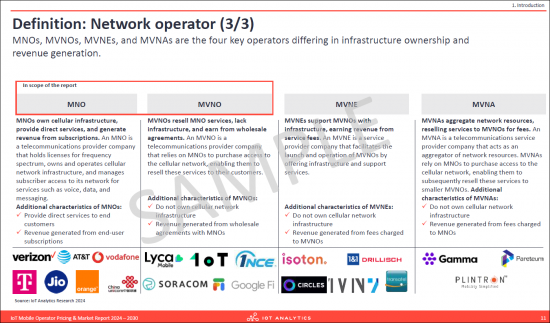
サンプルビュー
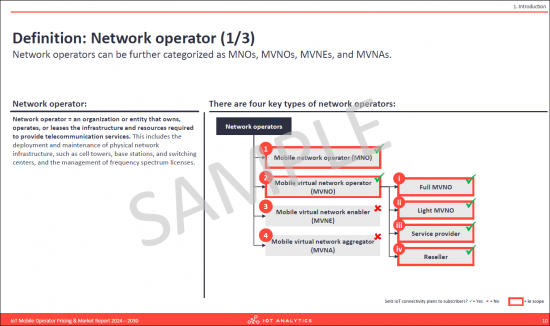
サンプルビュー
IoT料金データベースの構造
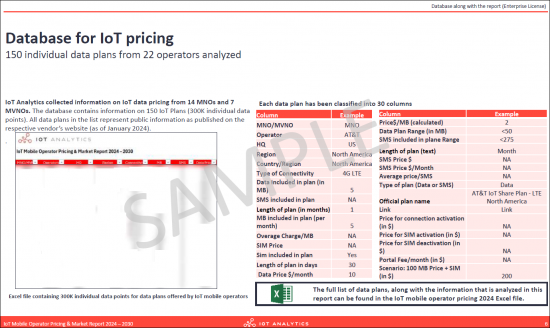
IoT Analyticsでは、MNO 14社とMVNO 7社からIoTデータ料金に関する情報を収集しています。このデータベースには、150のIoTプランの情報が含まれています。
掲載企業
本レポートで言及している企業の一部をご紹介します。
|
|
目次
エグゼクティブサマリー
第1章 イントロダクション
第2章 市場規模と展望
- 概要・重要ポイント
- 世界のセルラーIoT接続数
- 世界のセルラーIoT接続数:技術別
- 世界のセルラーIoT接続数:通信事業者別
- 世界のセルラーIoT接続数:産業別)
- 世界のセルラーIoT接続収益
- 世界のセルラーIoT接続収益:技術別
- 世界のセルラーIoT接続収益:通信事業者別
- 世界のセルラーIoT接続収益:産業別
第3章 競合情勢
- 概要・重要ポイント
- 競合情勢:概要
- 世界のセルラーIoT接続:市場シェア
- 世界のセルラーIoT接続:収益市場シェア
- AT&T:事業者の概要
- Verizon:事業者の概要
- Deutsche Telekom:事業者の概要
- Vodafone:事業者の概要
- Orange:事業者の概要
- Telefonica:事業者の概要
第4章 一般的なIoTの料金設定と請求に関する考察
- 概要・重要ポイント
- IoTの料金設定と請求に関する6つの重要な考察
- ベンダーの料金設定モデル
- ユーザー選択基準
- 請求構造のパラメータ
- 一般的な請求構造
- 料金モデルごとの請求構造
- 請求に関するサポートと機能強化
第5章 モバイル事業者のIoT料金ベンチマーク
- 概要・重要ポイント
- 調査手法:IoT料金データベース
- 料金分析の概要:MNOおよびMVNOのIoT接続データ料金
- 特定のユーザーシナリオにおける事業者の比較分析
- セルラーIoT接続データ料金:データ帯域別
- IoTモバイル事業者の料金比較:データ帯域別
- セルラーIoT接続データ料金:技術別
- IoTモバイル事業者の料金比較:技術別
- セルラーIoT接続のMBあたりの平均料金:データ帯域別
- IoTモバイル事業者の料金比較:データ帯域・MB別
- セルラーIoT接続のMBあたり平均料金:技術別
- IoTモバイル事業者の料金比較:技術・MB別
- MNOのセルラーIoT接続プランの料金:データ帯域別
- MVNOのセルラーIoT接続プランの料金:データ帯域別
- 料金比較:IoTモバイル事業者別
- MNOの1MB+1SMSあたりの料金:データ帯域別
- MVNOの1MB+1SMSあたりの料金:データ帯域別
- IoTモバイル事業者の料金比較:データ帯域別
第6章 市場動向と課題
- 市場動向と課題:概要
- 市場動向
- 市場の課題
第7章 調査手法・市場の定義
第8章 IoT Analyticsについて
The "IoT Mobile Operator Pricing & Market Report 2024-2030" is part of IoT Analytics' ongoing coverage of IoT hardware and connectivity. The report looks at the market for mobile operators and provides specific insights into different types of connectivity, data plans, and distinct offerings by Mobile Network Operators (MNOs) and Mobile Virtual Network Operators (MVNOs). Additionally, the report includes an IoT Mobile Operator Pricing benchmark, offering valuable insights into IoT pricing dynamics across different regions and types of connectivity.
SAMPLE VIEW

The main purpose of this document is to help our readers understand the landscape of cellular IoT mobile operators.
Overview of the IoT mobile operator market
The mobile operator market is undergoing a significant shift. Cellular IoT connectivity is experiencing explosive growth, with projections indicating it will account for 3.2% of total mobile operator revenue by 2030.
China Mobile currently dominates the global IoT landscape, boasting a remarkable 46.2% market share in global IoT connections (2023) .IoT Analytics' comprehensive research delves into trends and challenges within the mobile operator market. Notably, the data reveals a significant price disparity: Mobile Network Operators (MNOs) charge 77% more for the 101-500 MB data band compared to Mobile Virtual Network Operators (MVNOs) offering 4G LTE data.
SAMPLE VIEW
Definition: Network operator

A network operator is an organization or entity that owns, operates, or leases the infrastructure and resources required to provide telecommunication services. This includes the deployment and maintenance of physical network infrastructure, such as cell towers, base stations, and switching centers, and the management of frequency spectrum licenses.
Network operators can be further categorized into four types:
- 1. Mobile network operators (MNO)
- 2. Mobile virtual network operator (MVNO)
- 3. Mobile virtual network enabler (MVNE)
- 4. Mobile virtual network aggregator (MVNA)
SAMPLE VIEW

This report details six IoT pricing and billing considerations:
- 1. Vendor pricing models
- 2. User selection criteria
- 3. Parameters for billing structure
- 4. Common billing structure
- 5. Billing structures per pricing model
- 6. Biling support and enhancement
The included mobile operator pricing benchmark covers comparative analyses of operators for specific user scenarios:
- Cellular IoT connectivity data price by data bands in $
- Pricing comparison by IoT mobile operator by data band
- Cellular IoT connectivity data price by technology in $
- Pricing comparison by IoT mobile operator by technology
- Cellular IoT connectivity avg price per MB by data bands in $
- Pricing comparison by IoT mobile operator by data band and MB
- Cellular IoT connectivity avg price per MB by technology in $
- Pricing comparison by IoT mobile operator per technology and MB
- Cellular IoT connectivity plan price by data bands for MNO in $
- Cellular IoT connectivity plan price by data bands for MVNO in $
- Pricing comparison by IoT mobile operator
- Price per 1 MB + per 1 SMS by data bands for MNO in $
- Price per 1 MB + per 1 SMS by data bands for MVNO in $
- Pricing comparison by IoT mobile operator per data band
SAMPLE VIEW
IoT Pricing Database structure

IoT Analytics collected information on IoT data pricing from 14 MNOs and 7 MVNOs. The database contains information on 150 IoT Plans (300K individual data points) . Each data plan has been classified into 30 columns.
Questions answered:
- How large is the market for cellular IoT mobile operators (MNOs and MVNOs) and how is it expected to grow until 2030?
- How many cellular IoT connections are there and how are they distributed amongst various cellular IoT connectivity types?
- What does the competitive landscape of MNOs and MVNOs for IoT look like?
- How do IoT pricing plans for 22 key operators differ by the type of operator and type of cellular IoT connectivity?
- What are the average prices of cellular IoT connectivity for different operators?
- What are the key differences in pricing models and plans offered by MNOs and MVNOs?
- What 15 parameters influence IoT connectivity billing and pricing from an operator perspective?
- What are key emerging trends for MNOs and MVNO?
Companies mentioned
A selection of companies mentioned in the report.
|
|
Table of Contents
Executive summary
1. Introduction
- 1.1. Introduction: Chapter overview and key takeaway
- 1.2. How IoT Analytics defines the "Internet of things"
- 1.3. Definition: Connectivity
- 1.5. Global cellular IoT market forecast
- 1.6. Cellular IoT connectivity value chain
- 1.7. Definition: Network operators
- 1.8. Business model: Network operators
2. Market size & outlook
- 2.1. Market size & outlook: Chapter overview and key takeaway
- 2.2. Global cellular IoT connections 2018-2030 (in Bn)
- 2.3. Global cellular IoT connections by technology 2018-2030 (in B)
- 2.4. Global cellular IoT connections by operator 2018-2030 (in Bn)
- 2.5. Global cellular IoT connections by industry 2018-2030 (in Bn)
- 2.6. Global cellular IoT connectivity revenue 2018-2030 (in $Bn)
- 2.7. Global cellular IoT connectivity revenue by technology 2018-2030 (in $Bn)
- 2.8. Global cellular IoT connectivity revenue by operator 2018-2030 (in $Bn)
- 2.9. Global cellular IoT connectivity revenue by industry 2018-2030 (in $Bn)
3. Competitive landscape
- 3.1. Competitive landscape: Chapter overview and key takeaways
- 3.2. Competitive Landscape - Overview
- 3.3. Global cellular IoT connections - Market share (2022-2023)
- 3.4. Global cellular IoT connectivity - Revenue market share (2022-2023)
- 3.5. AT&T: Operator overview
- 3.6. Verizon: Operator overview
- 3.7. Deutsche Telekom: Operator overview
- 3.8. Vodafone: Operator overview
- 3.9. Orange: Operator Overview
- 3.10. Telefonica: Operator overview
4. General IoT pricing & billing considerations
- 4.1. General IoT pricing & billing considerations: Chapter overview and key takeaways
- 4.2 6 key IoT pricing and billing considerations
- 4.3. Vendor pricing models
- 4.4. User selection criteria
- 4.5. Parameters for billing structure
- 4.6. Common billing structure
- 4.7. Billing structures per pricing model
- 4.8. Billing Support and enhancement
5. Mobile Operator IoT pricing benchmark
- 5.1. Mobile operator IoT pricing benchmark: Chapter overview and key takeaways
- 5.2. Research Methodology - Database for IoT pricing
- 5.3. Overview pricing analysis: IoT connectivity data prices for MNO and MVNO
- 5.4. Comparative analysis of operators for a specific user scenario
- 5.5. Cellular IoT connectivity data price by data bands in $
- 5.6. Pricing comparison by IoT mobile operator by data band
- 5.7. Cellular IoT connectivity data price by technology in $
- 5.8. Pricing comparison by IoT mobile operator by technology
- 5.9. Cellular IoT connectivity avg price per MB by data bands in $
- 5.10. Pricing comparison by IoT mobile operator by data band and MB
- 5.11. Cellular IoT connectivity avg price per MB by technology in $
- 5.12. Pricing comparison by IoT mobile operator per technology and MB
- 5.13. Cellular IoT connectivity plan price by data bands for MNO in $
- 5.14. Cellular IoT connectivity plan price by data bands for MVNO in $
- 5.15. Pricing comparison by IoT mobile operator
- 5.16. Price per 1 MB+ per 1 SMS by data bands for MNO in $
- 5.17. Price per 1 MB+ per 1 SMS by data bands for MVNO in $
- 5.18. Pricing comparison by IoT mobile operator per data band
6. Market trends and challenges
- 6.0. Market trends and challenges: Chapter overview
- 6.1. Market trends
- 6.2. Market challenges
